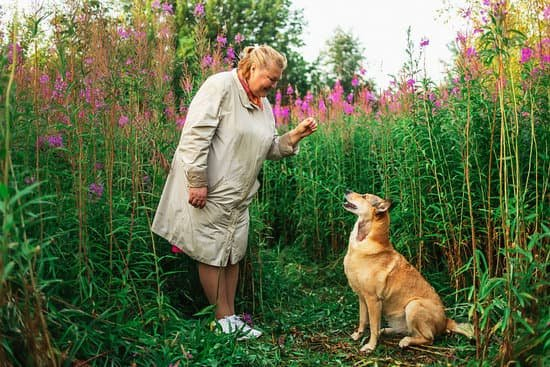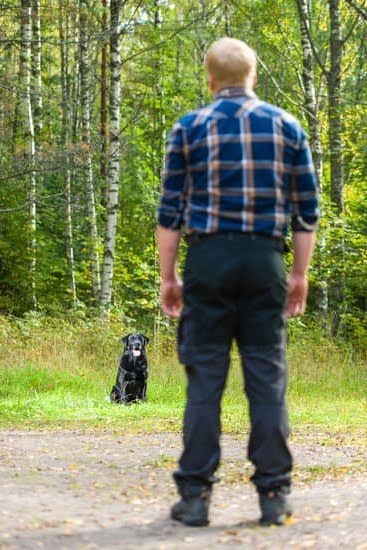Training your dog to walk at your pace is crucial for a harmonious and enjoyable walking experience. Learning how to train a dog to walk at your pace allows you to establish control, build a strong bond with your furry companion, and ensure both of you get the exercise you need. By setting the right pace and teaching your dog to walk beside you, you can create a positive and stress-free walking routine.
Understanding your dog’s behavior and body language while walking is key to successful training. Dogs communicate through their body language, so observing their cues can help you tailor the training methods accordingly. By recognizing signs of excitement, fear, or distraction, you can adjust your pace and techniques to effectively guide your dog during walks.
Setting the right pace for both you and your dog is essential in training. Finding a balance where both of you are comfortable ensures a smooth walking experience. Using tools and equipment such as harnesses, leashes, or treats can aid in training your dog to walk at your pace. Establishing a consistent walking routine and incorporating positive reinforcement techniques will encourage your dog to stay by your side and maintain the desired pace throughout the walk.
Understanding Your Dog’s Behavior and Body Language While Walking
Dogs communicate with us primarily through body language, so it’s essential to understand what your dog is trying to tell you while on a walk. By paying attention to their behavior and cues, you can better train them to walk at your pace. For example, if your dog is pulling on the leash or constantly stopping to sniff around, they may be feeling anxious or excited. It’s important to address these behaviors calmly and consistently during training sessions.
One key aspect of understanding your dog’s behavior while walking is recognizing their comfort level with the environment. Some dogs may feel overwhelmed in busy or noisy areas, leading them to pull on the leash or try to run off. By gradually exposing them to different environments and rewarding calm behavior, you can help them feel more relaxed and focused on walking at a steady pace with you.
Additionally, observing your dog’s body language can give you insights into their emotions while walking. Look for signs of stress such as panting excessively, low tail carriage, or ears pinned back. These signals indicate that your dog may not be comfortable with the current situation and might need a break or some reassurance from you. Understanding how your dog communicates will help you tailor your training methods to effectively teach them how to walk at your pace.
Setting the Right Pace for Both You and Your Dog
When it comes to training your dog to walk at your pace, one of the key aspects is setting the right speed that works for both you and your furry friend. Dogs are naturally curious and energetic, so finding a pace that allows them to explore while also keeping them focused on walking beside you is crucial.
Understanding your dog’s breed tendencies, age, and physical condition can help determine the appropriate speed for your walks. For example, high-energy breeds may require a faster pace than smaller or older dogs.
To start training your dog to walk at your pace, begin with short walks at a speed that is comfortable for both of you. Pay attention to your dog’s body language – a wagging tail and relaxed posture indicate contentment, while pulling on the leash or lagging behind may signal discomfort or disinterest.
Adjust your pace accordingly to keep your dog engaged and motivated during the walk. Gradually increase the distance and duration of your walks as you both become more accustomed to walking together.
Using the right tools and equipment can also aid in training your dog to walk at your pace. A properly fitted harness or collar can give you better control while ensuring your dog’s comfort. Consider using treats or toys as positive reinforcement to encourage good walking behavior.
Remember, consistency is key in training, so establishing a regular walking routine with clear expectations will help reinforce desired behaviors in your dog. By setting the right pace, being attentive to your dog’s needs, and using positive reinforcement techniques, you can enjoy quality walks together while strengthening your bond.
| Key Points | Details |
|---|---|
| Setting the Right Pace | Finding a suitable speed for both you and your dog based on breed tendencies and physical condition. |
| Body Language | Observing cues like wagging tail or pulling on leash to adjust pacing during walks. |
| Tools and Equipment | Using harnesses, collars, treats, and toys for effective training. |
Tools and Equipment That Can Help in Training Your Dog to Walk at Your Pace
Training your dog to walk at your pace can be made easier and more effective with the right tools and equipment. Here are some items that can aid in the training process:
- Collar and leash: A comfortable collar and a sturdy leash are essential for controlling your dog during walks. Opt for a harness if your dog tends to pull.
- Treats: Use high-value treats to reward your dog for walking at your pace. This positive reinforcement will encourage good behavior.
- Clicker: A clicker can be a useful tool to mark desired behavior while training your dog to stay by your side during walks.
Additionally, there are specific training aids that can help reinforce proper walking etiquette with your pup:
- Head collars or halters: These tools offer more control over your dog’s head movement, making it easier to guide them in the right direction.
- Long lines or training leads: Ideal for practicing off-leash walking in controlled environments, such as a fenced yard or park.
- Treat pouch: Keep your treats handy and easily accessible by using a treat pouch attached to your belt or waistband during walks.
By utilizing these tools and equipment, you can effectively train your dog to walk at your pace while maintaining control and reinforcing positive behavior. Remember to always use these items correctly and consistently during training sessions for the best results.
Establishing a Consistent Walking Routine for Training
Establishing a consistent walking routine is key when training your dog to walk at your pace. Dogs thrive on routine and structure, so having a set schedule for walks can help them understand what is expected of them. Here are some tips to help you create a successful walking routine for training:
- Set specific times for daily walks: Dogs appreciate consistency, so try to schedule walks at the same times each day. This will help your dog anticipate when it’s time to go for a walk.
- Start with short, frequent walks: When beginning the training process, start with short walks multiple times a day. This will help build your dog’s endurance and reinforce good behavior while walking.
- Choose familiar routes: Stick to familiar routes during the initial stages of training. Familiarity can help your dog feel more comfortable and confident while walking at your pace.
Training your dog to walk at your pace may require some patience and perseverance, but establishing a consistent walking routine can make the process smoother and more successful. Remember that every dog is unique and may require different approaches to training. By setting a regular schedule for walks, you can create a positive environment for both you and your furry friend to enjoy quality time together while working on improving their walking behavior.
Positive Reinforcement Techniques to Encourage Your Dog to Stay by Your Side
When it comes to training your dog to walk at your pace, positive reinforcement techniques can be highly effective. One of the best ways to encourage your furry friend to stay by your side is by using rewards such as treats, praise, or toys.
Every time your dog walks calmly beside you without pulling on the leash, make sure to reward them immediately. This positive association will help reinforce the behavior and make your dog more likely to continue walking at your pace.
Consistency is key when using positive reinforcement techniques. Make sure to reward your dog every time they exhibit the desired behavior of staying by your side during walks. This will help them understand what is expected of them and motivate them to repeat the behavior in the future. Remember that training takes time and patience, so be consistent in rewarding your dog until walking at your pace becomes a habit for them.
In addition to treats and praise, another effective technique for encouraging your dog to stay by your side is using clicker training. By associating the click sound with a reward, you can communicate with your dog more effectively during walks.
Click whenever your dog walks nicely beside you and follow up with a treat or praise. This method helps clarify exactly when your dog is doing the right thing, making it easier for them to understand how to walk at your pace.
| Positive Reinforcement | Benefits |
|---|---|
| Rewards such as treats, praise, or toys | Reinforce desired behavior |
| Clicker training | Enhances communication with your dog |
Dealing With Distractions and Obstacles During Walks
Identifying Common Distractions
When training your dog to walk at your pace, it is crucial to be aware of common distractions that can cause your furry friend to stray from the path. These distractions can range from other dogs, loud noises, tempting scents, or even squirrels running by. By recognizing these distractions early on, you can better prepare yourself and your dog to handle them during walks.
Techniques to Manage Distractions
One effective technique in dealing with distractions during walks is teaching your dog a strong “leave-it” command. This command will instruct your dog to ignore the distraction and focus on walking alongside you. Practice this command in a controlled environment first before using it during walks. Additionally, diverting your dog’s attention with treats or toys can also help redirect their focus back to you and maintain the desired pace.
Overcoming Obstacles Together
Obstacles are another challenge that may arise while training your dog to walk at your pace. Whether it’s navigating through crowded areas, crossing busy streets, or encountering unfamiliar objects, staying calm and patient is key. Use positive reinforcement techniques to encourage your dog to tackle obstacles with confidence. With practice and consistency, both you and your furry companion can overcome any obstacles that come your way during walks.
Troubleshooting Common Issues in Training Your Dog to Walk at Your Pace
Dealing With Pulling
One common issue that many dog owners face when trying to train their dogs to walk at their pace is pulling. When a dog constantly pulls on the leash during walks, it can make the experience frustrating and tiring for both the owner and the dog.
To address this issue, it’s important to use positive reinforcement techniques such as stopping in your tracks whenever your dog starts pulling and only moving forward when they come back to your side. Additionally, using a front-clip harness or head halter can help give you more control over your dog’s movements and discourage pulling.
Reacting to Distractions
Dogs are naturally curious creatures, and it is not uncommon for them to get distracted while out on a walk. Whether it’s by other dogs, squirrels, or enticing smells, distractions can cause your dog to veer off course and walk at their own pace instead of yours.
To address this issue, practice incorporating training exercises that focus on keeping your dog’s attention on you while walking. Use treats or toys to redirect their focus back to you whenever they get distracted.
Handling Fear or Anxiety
Some dogs may exhibit fear or anxiety during walks, causing them to either lag behind or rush ahead in an attempt to escape from perceived threats. In these cases, it’s essential to address the underlying cause of their fear or anxiety through desensitization training and gradual exposure to the triggering stimuli. By creating a safe and positive environment for your dog during walks, you can help alleviate their fears and build their confidence in walking at your pace.
Importance of Patience and Persistence in Training Process
Training your dog to walk at your pace can be a rewarding experience, but it requires patience and persistence. Dogs have their own unique personalities and learning abilities, so it’s essential to approach the training process with understanding and compassion. By remaining patient and consistent in your efforts, you can help your furry friend adjust to walking by your side and make the experience enjoyable for both of you.
It’s important to remember that dogs may not grasp the concept of walking at a human’s pace right away. Some dogs may naturally want to explore their surroundings, while others may be easily distracted by sights, sounds, and smells during walks. By being patient with your dog and understanding their behavior cues, you can work together to establish a comfortable walking pace that suits both of you.
Persistence is key when training your dog to walk at your pace. Consistency in your training routines, positive reinforcement techniques, and using the right tools can all contribute to a successful training process.
Keep in mind that every dog is different, so it may take time for your furry companion to fully understand what is expected of them. With dedication and perseverance, you can gradually teach your dog how to walk calmly by your side and enjoy quality bonding time during walks.
Conclusion
Training your dog to walk at your pace is not just about convenience; it’s also about building a strong bond with your furry companion. By understanding your dog’s behavior and body language, setting the right pace, using the appropriate tools, establishing a consistent routine, and practicing positive reinforcement techniques, you can create an enjoyable walking experience for both you and your dog.
It’s important to remember that each dog is unique and may require different approaches when it comes to training. Some dogs may respond well to treats and praise, while others may need more practice and patience. Regardless of the method you choose, consistency is key in reinforcing good walking habits.
Dealing with distractions and obstacles during walks is also part of the process. Whether it’s other animals, loud noises, or unfamiliar environments, staying calm and redirecting your dog’s attention back to you will help in maintaining a steady pace.
Remember that training takes time and effort, so don’t get discouraged if progress seems slow at first. With patience and persistence, you will soon be enjoying quality time with your dog while walking side by side at a comfortable pace.
Frequently Asked Questions
How Do I Get My Dog to Walk at My Pace?
In order to get your dog to walk at your pace, it is important to establish yourself as the leader of the walk. This means setting the pace and direction, using a consistent leash length, and rewarding your dog for walking calmly beside you.
It may take time and patience, but with consistent training, your dog should eventually learn to match your pace during walks.
How Do I Train My Dog to Walk Beside Me for Walks?
Training your dog to walk beside you on walks begins with teaching them basic leash manners and commands such as “heel” or “walk nicely.” Using positive reinforcement techniques like treats or praise when they walk beside you can encourage good behavior. Consistency is key in reinforcing this behavior until it becomes a habit for your dog.
How Do I Stop My Dog From Jumping Up When I Walk?
If your dog tends to jump up when you are walking, it is important to understand why they are behaving this way. Jumping can be a sign of excitement, attention-seeking, or even anxiety.
To address this behavior, it’s crucial to redirect their energy towards more appropriate activities like sitting or staying calm while walking. Consistent training and positive reinforcement will help discourage jumping up during walks over time.

Welcome to the blog! I am a professional dog trainer and have been working with dogs for many years. In this blog, I will be discussing various topics related to dog training, including tips, tricks, and advice. I hope you find this information helpful and informative. Thanks for reading!





